

Q is for Quality |

|

|

|

|
Quality is simply another term for Condition, which, to the discerning stamp collector, is paramount. Factors that should be considered in evaluating the Quality of a stamp include Centering, Gum condition (believe it or not, the condition of gum on stamps is so important that there's a profitable - though unethical - industry to regum old stamps), perforations, impression, color, freshness, and (on used stamps) cancellation. The ideal stamp has wide, even margins, equal on all four sides; unblemished gum; sharp, even perforations; crisp impression, or printing; bright color; and looks "fresh from the Post Office". A cancelled stamp should have a light, unobtrusive cancel, unless the cancel is itself the attraction, in which case it should be sharp and well-centered (i.e., SON = Socked On the Nose). The difference in value between a top quality item and an ordinary one can be astounding.
Interestingly, however, there are instances where extreme or visually appealing variations from the ideal, such as some part of a design's being radically off-center, can make a stamp more valuable than one that is perfect, e.g. the "grounded plane" and "fast plane" varieties of the first US airmail stamp.
Some stamps are not available in their ideal state, of course, in which case one speaks of their condition as good "for the issue", so it becomes important in many cases to know what typical examples of a stamp are like. Another important aspect of Quality is Authenticity - fakes and forgeries abound in the stamp market, so it is often critical to know how to distinguish the real thing from an imitation. In some cases the only way to be safe is to obtain an expert's certificate, authenticating a stamp as genuine (or denouncing it as faked).
See the bottom of this page for a list of references -
"Knowledge is Power".
Just to illustrate how critical issues such as centering, gum, and freshness can be to
the value of a stamp, below are three examples of Scott 310, all from the same recent
auction.
Be sure you do read those catalog writeups, because part of what is so entertaining
about these three stamps is the controversy about the first, and the fact that Siegel's
very aggressive and confrontational approach apparently paid off - the stamp on the left
sold for $7,000 + 10%, the one in the middle sold for $3,500 + 10%, and the one on the
right sold for $850 + 10%. Now I think that one fourth of catalog value is a reasonable
price for the third stamp. Calling its centering "Fine" is charitable, but the stamp is
indeed scarce in any condition. But, setting the issue of the gum aside, is the first
stamp worth twice as much as the second? Not to me.
My thanks to Siegel Auction Galleries for their permission to reproduce the images and
text from their catalog here.
----------------------------
The Buyers Guide,
This book is an essential reference if you are buying or selling valuable U.S. stamps,
i.e. any single stamp or set worth more than $100, which includes most 19th century and
many early 20th century issues other than the most common ones. The author analyzes
stamps either independently or as sets, with detailed information in four categories -
scarcity, premium characteristics, comments, and caveats. Armed with this data, you
should be able to make intelligent bids on these stamps at auctions, or to set reasonable
prices on ones you wish to sell.
----------------------------
The Expert's Book,
If you are trying to identify any of the U.S. Washington-Franklin issues of 1908-1923,
this is the book you need. A high-power magnifier, or a good scanner will help too. The
book tells you what else you will need, and exactly how to sort out all the confusing
issues and design types. The notes about how often particular stamps are faked are
extremely useful, since they help guide one in where to be most suspicious.
----------------------------
Top Dollar Paid,
If you are considering becoming a stamp dealer, or just want to sell your collection,
this book is an excellent place to start. It's somewhat out of date, now that the
Internet has become such a major factor in stamp buying and selling, but it's still quite
valid in the lessons it teaches, and it's entertaining to boot. The chapters on
Condition and Valuation are brief but especially useful.
----------------------------
How to Detect Damaged, Altered, and Repaired Stamps,
If you are building a serious collection of classic stamps, you need this book - it is
small, but every word is gold. Its examples are exclusively U.S. material, but much of
what it explains applies to all stamps. And while it is useful for the purposes listed
in the title, it has tremendous general value in helping you understand how to evaluate
stamps for purchase and sale.
The Price of Perfection

This stamp was issued in 1902. There were 2.6 Million copies printed, but fifty cents
was a lot of money then, so like most higher value issues, this one is not plentiful in
mint condition. Moreover, the margins allowed around the design are small, so centering
tends to be poor - these three are exceptionally good. The stamp catalogs $550. The two
stamps on the left are described as NH,
while the one on the right is LH. All
three are described as having "vibrant color and freshness". What do you think they sold
for? Wait, before you decide, look at the table below.
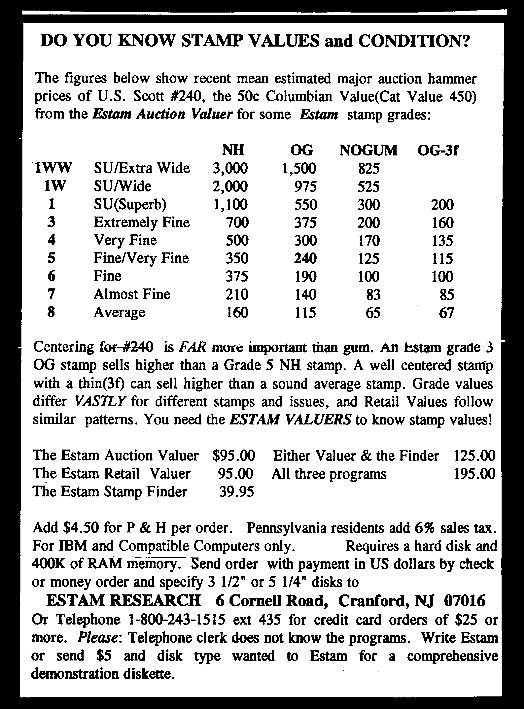
I cut that table out of a philatelic newspaper about four years ago (I can't find any
current referrence to the advertiser, so they may not be in business any more), and it
relates to an entirely different stamp, but it illustrates how far from catalog value a
particular stamp's value can vary, based on seemingly tiny variations above or below the
norm.
The three stamps shown at the start of this section sold for $3,000+10%, $850+10%, and
$1,100+10%, respectively! Knowing that, can you see what made the difference? Can you
see why the one on the left was judged so nearly perfect that it realized over five times
catalog value, and almost three times as much as the one on the right? If not, don't let
it worry you, I'm still amazed myself.
5/14/2002 - Here's another, more recent example of the effect of condition on value.
The differences in the stamps involved are far more dramatic, making it easier to see why
someone would pay more for the best than either of the other two, but the magnitude of
the difference in values is pretty astounding. The three stamps below were all sold in
Siegel's Sale 843, held Feb 27 to March 1, 2002. Click here to view the auction catalog descriptions of these stamps.
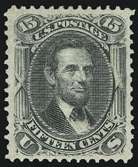


CAVEAT EMPTOR!
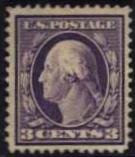
I bought this stamp as part of a large collection, and with the understanding that while
most of the contents were authentic, there were probably some fakes as well, and the sale
was "as-is". I got enough out of the deal to make it worth my while, but did find some
fakes. This stamp was a prime suspect right away. It looks like Scott 359, the bluish
paper variety, which catalogs $1,800! Its centering is excellent for that stamp. But
when I examined it under high magnification, and checked for the telltale signs described
in such guides as The Expert's
Book, I noticed a distinct blue tinge around the tips of the perfs. Moreover,
when I compared it with a cheaper bluish paper that I was sure of, I could see this one
was regummed. Nonetheless, a couple of dealers I showed it to pronounced it genuine. I
thought of selling it, leaving the issue to someone else to resolve, but then decided I
preferred to know. Besides, any smart buyer would insist on a certificate for such an
item, and I value my reputation as someone who buys and sells honestly and with integrity.
Below is the certificate I got back from the APES. As you can see, they agreed with my
suspicions, and the stamp is essentially worthless.
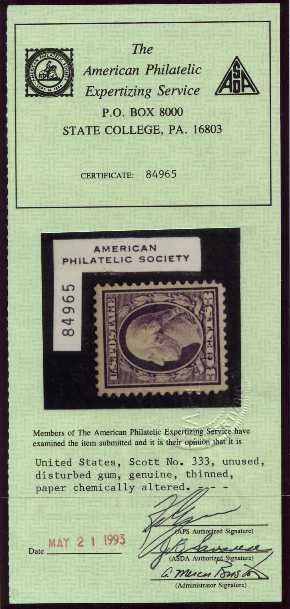
"But it looks so good", you might say. And "If the dealers you showed it to thought it
was authentic, why trust the APES?" Good questions, and if I had paid a high price for
the stamp, I might challenge the certificate, but I'm pretty sure the result would be the
same from any of the other expertizing
services. What they have - that a dealer giving me a casual opinion (while he watches
out of the corner of his eye to make sure the guy looking through that box over there is
not stealing anything) does not have - are reference collections of the real thing plus
other fakes, and a panel of experts who spend a lot of time doing nothing but expertizing
stamps, so they have the experience to do it reliably. They are not infallible, but
their own reputations are at stake, so they don't make judgments like this without good
reasons. My only gripe is that they do not list those reasons - I would like to know
exactly how they reached their decision.
"But wait!" you say - "Are you implying that all dealers are dishonest or incompetent?"
Absolutely not. I have great respect for both of the dealers I showed the stamp. I
never told either about my own suspicions, and if I had, I am sure both would have shared
them. Successful dealers must learn to use their time effectively, and make such
judgments quickly, and settle for being right most of the time but making an occasional
mistake. The proof of their integrity is that they will take back anything they sell if
it turns out to be other than what you bought it as, and you make the claim within a
reasonable amount of time. I've written more on the economics of buying and selling
stamps, here.
Finally, you may wonder why the certificate says nothing about Scott 359, which is what
I told the expertizers I thought the stamp might be. Instead, the cert. just says it
is Scott 333, and "genuine", but with chemically altered paper. This bothered me at
first, but then I realized it's the only way to go. The expertizer's job is to say
what the stamp IS, not what it isn't - which could be a long list! AND, in other
cases, stamps I thought were one thing came back identified as something more
valuable, so I was very glad to know what they were, rather than what they were not.
Gaudeat Emptor!
What's wrong with this picture?

I must have been bored when I sent this one in - I did not suspect any sort of fakery,
nor think it was anything but a type III Schermack of Scott 409. But it looked odd, and
for some reason I could not figure out why. Besides, I was going through a phase where I
sent stamps in for any reason at all - I figured it was worth it for what I could learn.
Here's what I got back:

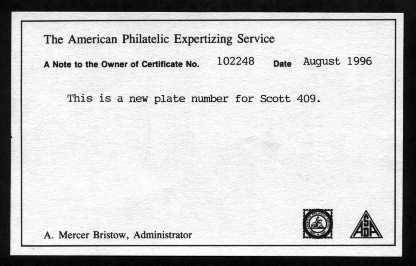
I admit I was pleased, though a bit embarrassed I didn't realize the stamp had been re-
glued to expose the plate number - that's what had bothered me about the stamp, but I
didn't take the time to figure it out. And I just had no idea people ever DID that.
Here's what it must have looked like originally.
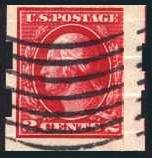
So someone thought that plate number was important enough that they took the trouble to
reveal it, yet they did not report it to the committee of collectors that keeps records
of plate numbers. I got out my 1997-1998 Durland catalog, and sure enough, 7084 is there for number 406 (same
stamp, perforated), but not for 409. So what I learned in this case was that collectors
do strange things. (Click here if you want
to know what a pasteup is.)
Which Grill?

Is that an ugly stamp, or what? It's smudged, it's stained, it's poorly centered,
it's got that ugly cancel - I think I bought it as a space filler, and for that
reason have never tried to sell it - it's not worth enough to bother, even though its
catalog value, as Scott 89, used, is $260. But at about the same time I sent in the 409
above, I sent in this one as well, to see how well I had done evaluating it.

I was pretty sure it was a "D" grill (easier to see from the back, above), so Scott 89,
and not an "E" grill, which would be Scott 96 (catalog value used = $150). And I figured
it had been reperfed on the right side. Those perfs look too neat and regular,
especially compared to the other three sides. Here's the certificate I got back.
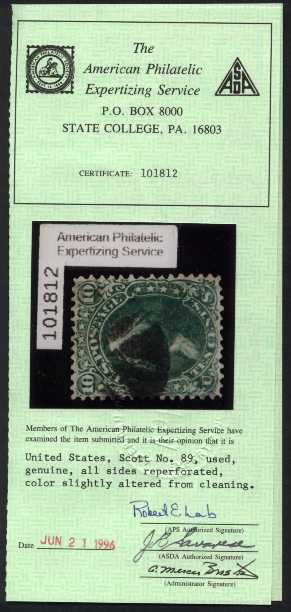
Wow! Reperfed on all 4 sides! WHY? It's not worth enough to be worth the trouble, I
would have thought. As for the cleaning, I think I can explain that - it was so messed
up on the back with old hinges and traces of gum and all that I gave it a good bath. It
made seeing that grill a lot easier, and to my eyes improved the overall appearance of the
stamp. Heck, if I'd left it as it was, the expertizers probably would have told me the gum
was faked. But I guess it did fade it a little.
So what did I learn in this case? Collectors (including me) do strange things.
And I sure wonder what that stamp looked like before it was doctored, if this was an improvement.
REFERENCES
As I remind you at the top of this page, "Knowledge is Power", and that is especially
true when buying and selling stamps. The books below should help you get started on the
road to informed judgments.
by Stephen R. Datz; General Philatelic Corp.
by Paul W. Schmid, Palm Press, 1990
by Stephen R. Datz; General Philatelic Corporation, 1989
by Paul W. Schmid; Palm
Press, 1979
| Home | P is for Plate Number Coil <<< | Contents | >>> R is for RPO | Credits |
All text Copyright © 2000, William M. Senkus
Send feedback to the webmaster: CLICK HERE
Revised -- 05/14/2002
